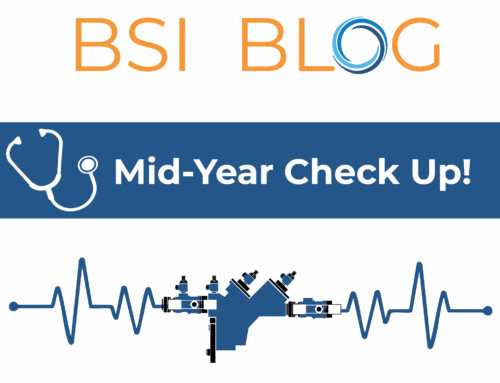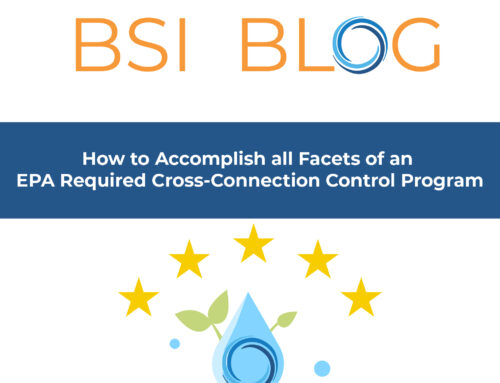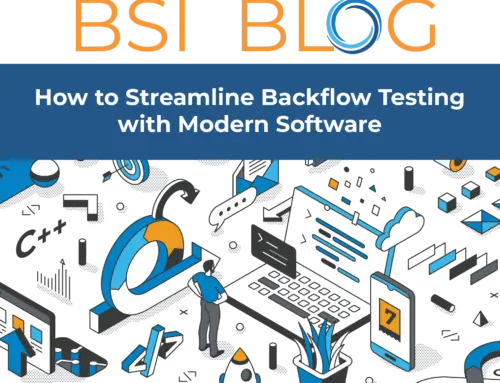Backflow Industry Standards with BSI’s Backflow Academy
Although very niche, the backflow/cross-connection industry is booming. BSI Online wants to pour resources into education and provide answers the backflow community may have. For over 20 years, BSI has partnered with municipalities and water purveyors to develop comprehensive backflow prevention programs with the aim of protecting our precious water resources across the United States and Canada. To get your frequently asked backflow industry questions answered, continue reading!
Question: What is backflow?
Backflow is the undesirable reversal of flow of non-potable water. This occurs through a cross-connection and into the piping of a public water system or consumer’s potable water. There are two types of backflow: backpressure and backsiphonage
- Backpressure: created when the pressure within the customer’s system becomes greater than the water supply pressure. Elevated tanks, heating systems and booster pumps are some of the main causes of backpressure.
- Backsiphonage: created when there is a negative or reduced pressure in the water supply main. Water main breaks or hydrant flushing are two of the main causes of backsiphonage.
Potable Water = Drinking Water ????
Question: What is cross-connection?
A cross-connection is any actual or potential connection between the public or consumer’s potable water system and any non-potable source or substance that presents a hazard to the quality of the public or consumer’s potable water system. Therefore, cross-connection control is the management or “control” of these cross-connections to protect public safety by preventing backflow incidents within the public or water consumer’s potable water system.
Question: What is a backflow preventer?
A backflow preventer is a device or assembly that is a means to prevent backflow. This device provides a physical barrier to backflow while protecting potable water supplies from contamination, it allows water to flow in one direction but never in the opposite direction.
Question: How is a backflow assembly tested?
A qualified professional in your jurisdiction will utilize a backflow preventer test kit. The backflow preventer test kit is a compact portable device that measures differential pressure and is used for all testing of backflow prevention assemblies (DCVA, RP, PVB and SVB types). Depending on the model, test kits come equipped with either 3 or 5 soft seated needle valves. Equipped with a full-face scale, the kit can measure a range of 0-15 psid (psi differential). Test kits are equipped with three color-coded service hoses with inline filters for connecting the test kit to the backflow prevention assembly.
Manufacturers of backflow assemblies and most regulating authorities require annual testing to ensure the assembly is functioning properly. Backflow assemblies are mechanical devices. Just like car maintenance with regular oil changes, a backflow assembly must be checked to ensure it functions properly.
Question: What happens if the backflow assembly fails a test, do they need to be repaired?
Yes! If a backflow assembly fails the test and does not meet state standards per device type, the assembly must be repaired. The water purveyor determines the time required to have the repairs made. After repair, the assembly must be re-tested to ensure proper functionality.
Question: Who has a responsibility for an approved and effective cross-connection control program?
EVERYONE!
The water purveyor, local plumbing authority, water consumers and all individuals performing backflow prevention assembly installation, testing and repairs have some level of responsibility for ensuring an effective, efficient cross-connection control program. The individuals performing backflow prevention assembly installation, testing and repairs are responsible for following all codes and regulations as outlined by the state and local cross-connection control program. The local plumbing authority is responsible for implementing and enforcing the local plumbing codes. The water consumer is responsible for preventing unprotected cross-connections and maintaining protected cross-connections within the water consumer’s facility.
Cross-connection control management is a complex job. Our Backflow Academy is here to help answer your questions, click here to learn more. It is imperative to have an effective cross-connection management program in place to prevent the dangers of backflow and protect clean, drinking, water from cross-connection.
Are you in need of a solution and service with all the tools necessary for successfully managing a cloud-based backflow data management program? To read all our program features, click here! Interested in booking a demo with our BSI Sales Team? Click here!











